How does auto-focus work and what really is the sharpest aperture on a lens? let’s have a look…
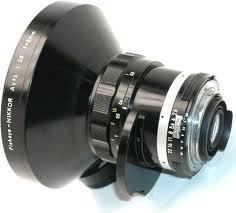
Fish Eye
The lens at the top of this article is a Nikon 8mm circular fish-eye, from around the mid 1970’s. A fish-eye lens is super wide angle and gets it’s name because it makes no attempt to correct the lens curve distortion that you get with a wide optic. In fact it makes a virtue of it. A fish-eye lens can produce a view of up to 180° in the horizontal, vertical and diagonal planes, but not all of them do. Fish-eyes come in two types; Circular fish-eyes project a circular images onto the camera sensor, so you get a black surround like this:
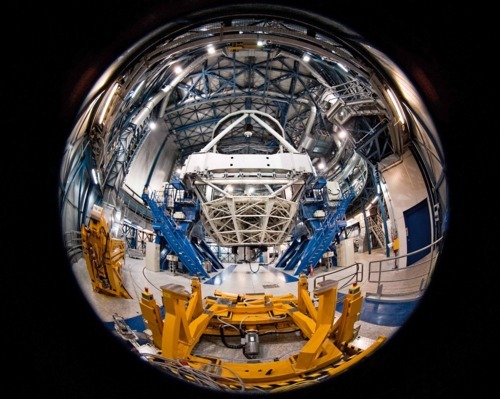
We all know about lenses right? Wide angles, telephoto, zoom; what about variable maximum apertures, image stabilization, fish-eyes and mirror lenses? How does auto-focus work and what really is the sharpest aperture on a lens? let’s have a look…
Fish-eye’s also come as full-frame versions that project the circular image outside the camera sensor, in other words the sensor takes a rectangular crop out of the middle of the circular image. Like this:
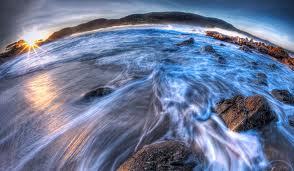
So fish-eye’s are special purpose, special effects lenses and which are great for some photography but obviously not for all!
Wide Angle lens
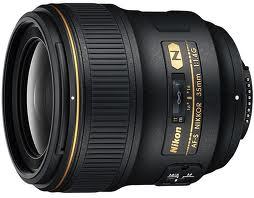
This is a wide angle lens for FX or full frame cameras. It’s not very wide angle - only 35mm - and if you put it on a Dx or APS sensor camera, it would produce an image that looked more like a standard lens because of the crop factor (Dx Vs Fx in a separate post). It’s also a prime lens, rather than a zoom lens, which I will discuss later on.
Wide lenses are all about the foreground. They emphasis what’s right in front of your feet and de-emphasis, or reduce what’s in the distance. This explains why so many wide angle scenic pictures taken of views look disappointing.
Wide lenses are all about the foreground. They emphasis what’s right in front of your feet and de-emphasis, or reduce what’s in the distance. This explains why so many wide angle scenic pictures taken of views look disappointing.
When you are looking at a view, you have the ability to focus in on the background subjects each in turn and build a mental map of each little bit, projecting the whole in your minds eye. A camera can’t do this. If the background elements are small in the viewfinder they will look small in the photo. And if they are small, they will be insignificant. The things that look big to a wide angle lens are right in front of you, and they will be the most dominant subjects in your photo. So when you put a wide angle on your camera you what to be thinking about the foreground and you want to make sure it has something interesting in it, because that’s what the viewer is going to be looking at.
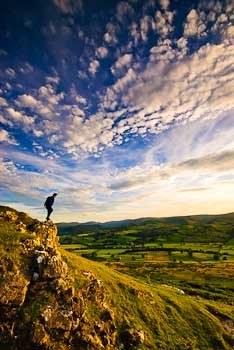
This is a wide angle shot. Look at the background - small isn’t it? Look at the foreground - see how it dominates the view?
Problems with wide angle lenses
Wide lenses have some optical problems that need to sorted out if they are to perform well. They tend to distort vertical and horizontal lines. This is called barrel distortion.

In extreme cases the verticals and horizontals can look like they were shot using a fish-eye! This is not good. Fish-eye’s are supposed to do that, wide angles are not. Any decent lens review will highlight any distortion problems that a particular lens has, and indicate how they might be addressed.
However, it’s worth knowing that if you dip any wide angle lens downwards, all the verticals will diverge, like this;

See how the vertical lines lean outwards at the edges?
If you tilt any wide angle lens upwards, the verticals will converge, like this:

We’re all familiar with that look, every time we look up at a skyscraper building we get the same effect.
So to keep the verticals all straight when we need to, as in architectural photography, we must ensure the lens is absolutely level. You’ll need to use a tripod and a maybe even a clip on spirit level (clips onto the camera hot-shoe) to make sure. You can also use the grid lines in your viewfinder to help keep things level.
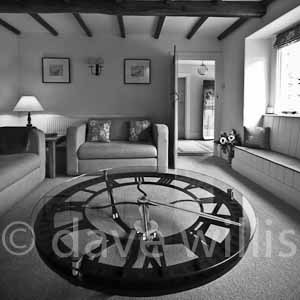
See this interior shot? Look at all the verticals throughout the image. See how straight they are? Attention to detail and discipline in looking through the viewfinder at every vertical line will help to achieve this, coupled with some common sense - don’t use the widest angle lens you have. If you are using a wide angle zoom, as many of us do, back it off a little bit to give the lens a bit more leeway.
Lens flare
Wide angle lenses have a tendency to produce large amounts of flare from the light source because of the the large, curved surface area of the front element. Despite modern anti-reflective lens coatings and other measures, flare is still a problem any time you point the lens in the direction of the light, be it the sun or a flash gun or a flood light. It’s a good idea to get used to using a lens hood with wide lenses to help shade the lens from light sources.
Wide angle lenses have strange looking lens hoods with cut out sides, specially designed to offer shade to the front element without encroaching on the field of view. The lens “sees” a wider image than vertical because the sensor is cropping a rectangle out of of a round image circle and the rectangle is longer in width than in height, so the lens hood can’t project forwards at the sides without being seen.
Last point about wide angle lens hoods; Take them off before you use the pop-up flash, the flash catches the upper edge of the hood and creates a shadow across your subject!
Image fall-off All lenses suffer to one degree or another from image brightness fall-off. In other words, the image gets darker out towards the corners. Lenses are at their best in their centers - they are sharper and brighter. As you travel out from the center point in an image circle, the image becomes progressively darker and less sharp. If the differences in sharpness and brightness are not easily apparent to the eye, then the lens will be high quality, if the changes are obvious then the lens is a dud!
Here’s an illustration of a two-lens comparison chart; Good lens on the right, bad one on the left. This darkening, in the corners is what we call “vignetting” and most lenses get rid of it by the time you stop down to around f5.6, after which it isn’t much of a problem.
Standard lens
What do we mean by “standard”? Closest to the field of vision of the human eye is the normally accepted definition and in 35mm film or FX full frame digital cameras that means a 50mm lens, whilst on APS or Dx-sensored cameras it’s somewhere between 32 and 36mm depending on the exact crop ratio of your camera sensor. A Nikon d5100 for example, has a Dx crop of 1.5, so a 33mm lens multiplied by 1.5 is equivalent to 49.25mm.
The standard 50mm prime lens is a very under-rated piece of kit. First of all, it’s a very simple piece of optical engineering so it’s practically distortion-free, it’s very cheap to manufacture and it’s often incredibly sharp at all apertures. Because it’s simple to make, it often comes in a variety of maximum aperture sizes from f2.8, f2, f1.8 and even f1.4! That last one, the f1.4 version makes it one of the fastest lenses you can buy. With f1.4 you can almost shoot hand-held at night! And it gets better; f1.4 creates amazingly short depth of field when used on close subjects, enabling you to produce very creative, individual images.
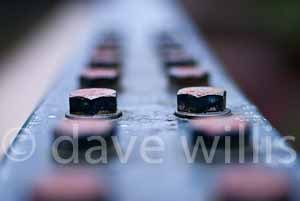
Remember too, that 50mm when used on a Dx crop sensor produces in image equivalent to a 75mm lens - that’s the same as a standard short portrait lens. Many professional photographers carry a light, small, fast 50mm lens in their pocket as a back-up and for when they want to shoot hand-held, natural light images indoors.
Telephoto Lens
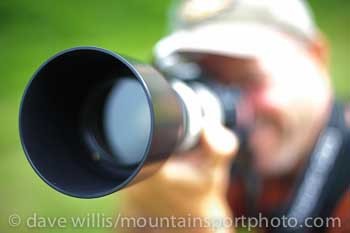
Any lens that magnifies the subject in the viewfinder can be considered a telephoto but the actual definition is a lens that has a shorter overall physical length than it’s actual focal length, due to the use of a special of group of internal lens elements known as a telephoto group.
Typically, a telephoto lens would start at around 70mm and continue up to, well I believe the biggest telephoto lens currently available is Canon’s 5200mm! It’s special order only, so don’t look for it in your local camera store.
Back in the real world, most of us will be using something like a 70-200 or 70-300mm telephoto zoom but before we talk about zoom lenses, let’s stick with the most common prime lens telephoto sizes.
Telephoto lenses are made as either standard “consumer” design or “pro” versions, which have a higher or larger maximum aperture value and often also include better anti-reflective coatings and high grade glass.
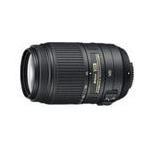
Above: This is a Nikon Dx G ED VR 55-300 f4.5/5.6 zoom lens. It zooms out to 300mm but the fastest maximum aperture at that focal length is f5.6. That means you might not be able to use a fast shutter speed in low light (so you’ll get camera shake), you can’t get a really short depth of field (so your backgrounds may not be as out of focus as you might like) and the auto focus may not work quite as well in low light because the max aperture isn’t bright enough for the lens to “see” very well. This lens costs £320 new.
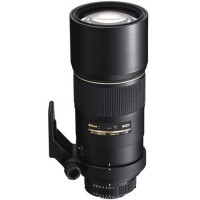
Above: This is the Nikon 300mm f4 ED IF AF-S prime lens (not a zoom). It has a maximum aperture of f4, 1 stop brighter than the previous lens. It has ED glass (extra-low dispersion) which improves contrast, colour and optical performance. It has IF (internal focusing) so the lens length doesn’t change or rotate when focusing (good for using filters) and it has a 9 blade rounded diaphragm which improves the look of out-of-focus highlights, which is what we refer to as “bokeh” (a Japanese term). It costs £825 new - more than twice the cost of the 55-300 f5.6 zoom.
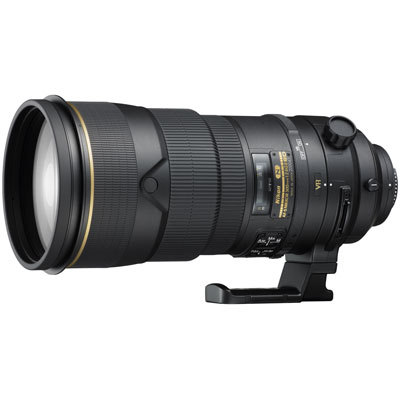
Above: This is the very latest Nikon 300mm f2.8, G, ED, VRll AF-S lens. It has a maximum aperture of f2.8, four times brighter than the f5.6 zoom we started with. To achieve this, the lens has a very large front element to gather as much light as possible but this makes the lens big and heavy. It’s hard to hand hold all the time so it has a tripod collar and foot to enable the use of a monopod to take the weight. It also has VR; Vibration Reduction, Nikons own image stabilisation system to try and cut down on image shake when using slower shutter speeds. It too has high quality ED glass construction and internal focusing and the AF (auto-focusing) system is built into the lens making it fast, responsive and quiet. This is a professional spec sports, action and wildlife photographers lens. You could match this with a high quality teleconverter (made specially for this lens by Nikon) to turn it into a 600mm f5.6 lens. This lens costs - wait for it - £4057! Yes, you read that correctly.
So, all three of these lenses will get you to 300mm, a good telephoto focal length. One is a zoom and DX, in other words designed for the smaller DX sensor camera, which means it actually produces an image that is 450mm not 300mm. But it’s a “slow” lens and you can’t use it on a full frame (FX) camera. The second at F4 is high quality, prime lens and designed for FX cameras. You can use it on a DX camera and get an f4 450mm - which is very nice, but costs a lot more. Finally you could have the f2.8 version with all the latest technology but at that price you would really need to justify this lens.
Prime Vs Zoom
Most lenses sold these days are zooms. That is to say they have the ability zoom through a range of focal lengths. A prime lens is one that has only a single, fixed focal length - which was how nearly all lenses used to be prior to about 1975! Initially zoom lenses were not as sharp or as good quality as prime lenses and sometimes you hear that particular piece of “advice” still sprouted. Ignore it. Modern zoom lens technology and lens construction means that just about all good quality zoom lenses will perform at least as good and sometimes better than their prime lens equivalents. However, when it comes to speed, by which we mean the maximum lens aperture, prime lenses can sometimes have the edge. It’s easier to construct an f2.8 prime lens than an f2.8 zoom lens.
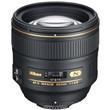
This is a Nikon 85mm f1.4 prime lens. This is considered to be a great portrait lens and is only available as a prime lens. The very fast maximum aperture is useful for extremely short depth of field portraits.
The main difference that you have to think about with zoom lenses is thevariable max aperture that you get with most consumer zoom lenses. A zoom lens has a natural tendency to absorb a lot of light as the focal length is zoomed out. There’s a lot of lens elements, barrel absorption, internal reflections and other stuff going on inside a zoom lens as you zoom it out to 300mm or whatever with the net result that light reaching the camera sensor has lost a fair bit brightness by the time it gets there. This results in the actaul exposure going down by as much as 1.5 stops of brightness. If your zoom says, on the lens barrel or front element ring, something like 1:4.5/5.6 it means that at the short end of the zoom range you have a max aperture of f4.5 but when you zoom out to the telephoto end, this reduces to f5.6.
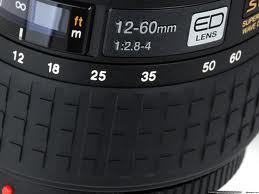
The aperture is not physically changing, it’s just the brightness value of the light, so it;s as though you had changed the aperture from f4.5 to f5.6.
This has some implications when you are working with zoom lenses. If you zoom in when using aperture priority mode, your shutter speed will drop, you could get camera shake! And if you are in manual mode your image will be underexposed unless you compensate with either a slower shutter speed or a higher ISO. In shutter priority your aperture will change and again you could get an underexposed image. Beware variable maximum apertures!
Pro-spec zooms often have a fixed maximum aperture all the way through the zoom range and often it’s a fast one! F2.8 70-300mm zooms are fast and stay at f2.8 all the way from 70mm to 300mm, but that’s one of the reasons they cost up to £1600.
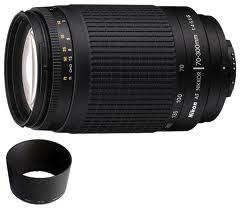
This is Nikon’s 70-300mm f4.5/5.6 which costs about £150
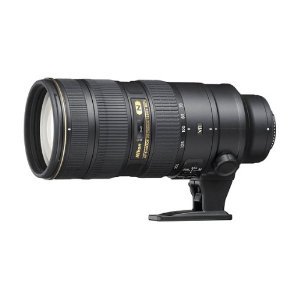
This is Nikon’s 70-200mm f2.8 pro spec lens - this costs about £1700.
Teleconverters:
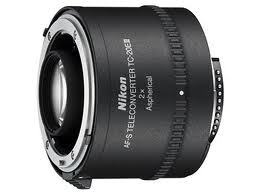
Many telephoto lenses have a teleconverter designed specifically to go with them - matched teleconverters. If you are considering buying a teleconverter to extend the reach of your lens, it is definitely worth investing the extra money in a matched t/c which will retain all the auto-focus capability of your telephoto lens and will be optically matched to get the best out of the lens combination. Cheap teleconverters are not worth buying - they will produce a very poor image quality and you’ll be disappointed. You are better off buying a used, high quality t/c designed for your lens rather than a new budget universal one.
A teleconverter basically magnifies the image produced by the lens by a certain factor. A 1.4 t/c will increase your focal length by x1.4 and a x2 t/c will double your focal length. However, as with all things in photography, there’s a payback…when you fit a x2 t/c to an f2.8 lens you loose 2 stops of exposure, so your f2.8 becomes an f5.6. same goes with any other t/c. And a x1.4 will loose you about one and a half stops, so an f2.8 becomes an f4.5 and so on. If you only have an f5.6 telephoto lens and you couple it with a x2 t/c you will be down to f11 which has severe repercussions for your shutter speeds!
More stuff about lenses
Mirror Lens:
Mirror lenses are a bit specialised and can be difficult to both find and to use!
Bokeh:
This a Japanese term that refers to the way out-of-focus spectral highlights (points of light) are rendered by a lens.
Image stabilisation:
IS, VR OS…. image stabilisation (Canon) Vibration reduction (Nikon) or Optical stabilisation (Sigma et al) all work in fundamentally the same way when they are built into the lens rather than in the camera. They use electronic “gimbaled” floating optics that are motor-controlled to counteract any movement that is detected in the lens and try to introduce an opposite movement that cancels out the camera shake…in theory. And it works!
Macro lenses:
The definition of a Macro lens is a lens that reproduces an image at life size or larger, in other words if you focus on something like a bee, the image that the lens renders on the camera sensor should be the same size or larger than the bee itself. By that measure, most lenses that purport to be macro or have a macro capability are not strictly macro, they are merely close-up lenses which is not the same thing.
No comments:
Post a Comment